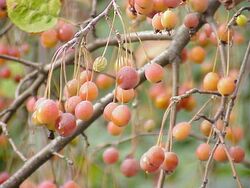Biology:Malinae
| Malinae | |
|---|---|

| |
| Malus sikkimensis fruit | |
| Scientific classification | |
| Kingdom: | Plantae |
| Clade: | Tracheophytes |
| Clade: | Angiosperms |
| Clade: | Eudicots |
| Clade: | Rosids |
| Order: | Rosales |
| Family: | Rosaceae |
| Subfamily: | Amygdaloideae |
| Tribe: | Maleae |
| Subtribe: | Malinae Reveal[2] |
| Genera | |
|
See text | |
| Synonyms | |
| |
Malinae is the name for the apple subtribe in the rose family, Rosaceae. This name is required by the International Code of Nomenclature for algae, fungi, and plants, which came into force in 2011 (article 19) for any group at the subtribe rank that includes the genus Malus but not either of the genera Rosa or Amygdalus.[3] The group includes a number of plants bearing commercially important fruits, such as apples and pears, while others are cultivated as ornamentals.
The tribe consists exclusively of shrubs and small trees characterised by a pome, a type of accessory fruit that does not occur in other Rosaceae, and by a basal haploid chromosome count of 17 (instead of 7, 8, 9, or 15 as in the other Rosaceae). There are approximately 28 genera with approximately 1100 species worldwide, with most species occurring in the temperate Northern Hemisphere.
Taxonomy
The Malinae as currently circumscribed include the following genera:[4][5]
References
- ↑ "Rosales". http://www.mobot.org/MOBOT/research/APweb/orders/rosalesweb.htm.
- ↑ Reveal, J.L. (2012). "Newly required infrafamilial names mandated by changes in the Code of Nomenclature For Algae, Fungi, and Plants". Phytoneuron 2012-33: 1–32. http://www.phytoneuron.net/PhytoN-InfrafamNames.pdf.
- ↑ "International Code of Nomenclature for algae, fungi, and plants". http://www.iapt-taxon.org/nomen/main.php?page=art19#19.5. Retrieved 2015-02-01.
- ↑ Campbell, C.S.; Evans, R.C.; Morgan, D.R.; Dickinson, T.A.; Arsenault, M.P. (2007). "Phylogeny of subtribe Pyrinae (formerly the Maloideae, Rosaceae): Limited resolution of a complex evolutionary history". Plant Systematics and Evolution 266 (1–2): 119–145. doi:10.1007/s00606-007-0545-y.
- ↑ Rushforth, Keith (2018). The Whitebeam problem, and a solution. Phytologia 100(4): 222-247. 21 December 2018.
- ↑ Stace, C. A. 1975. Hybridization and the flora of the British Isles. Academic Press, London.
Wikidata ☰ Q6743716 entry
 |

